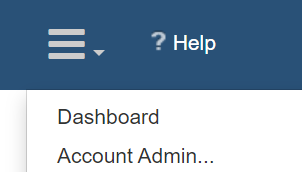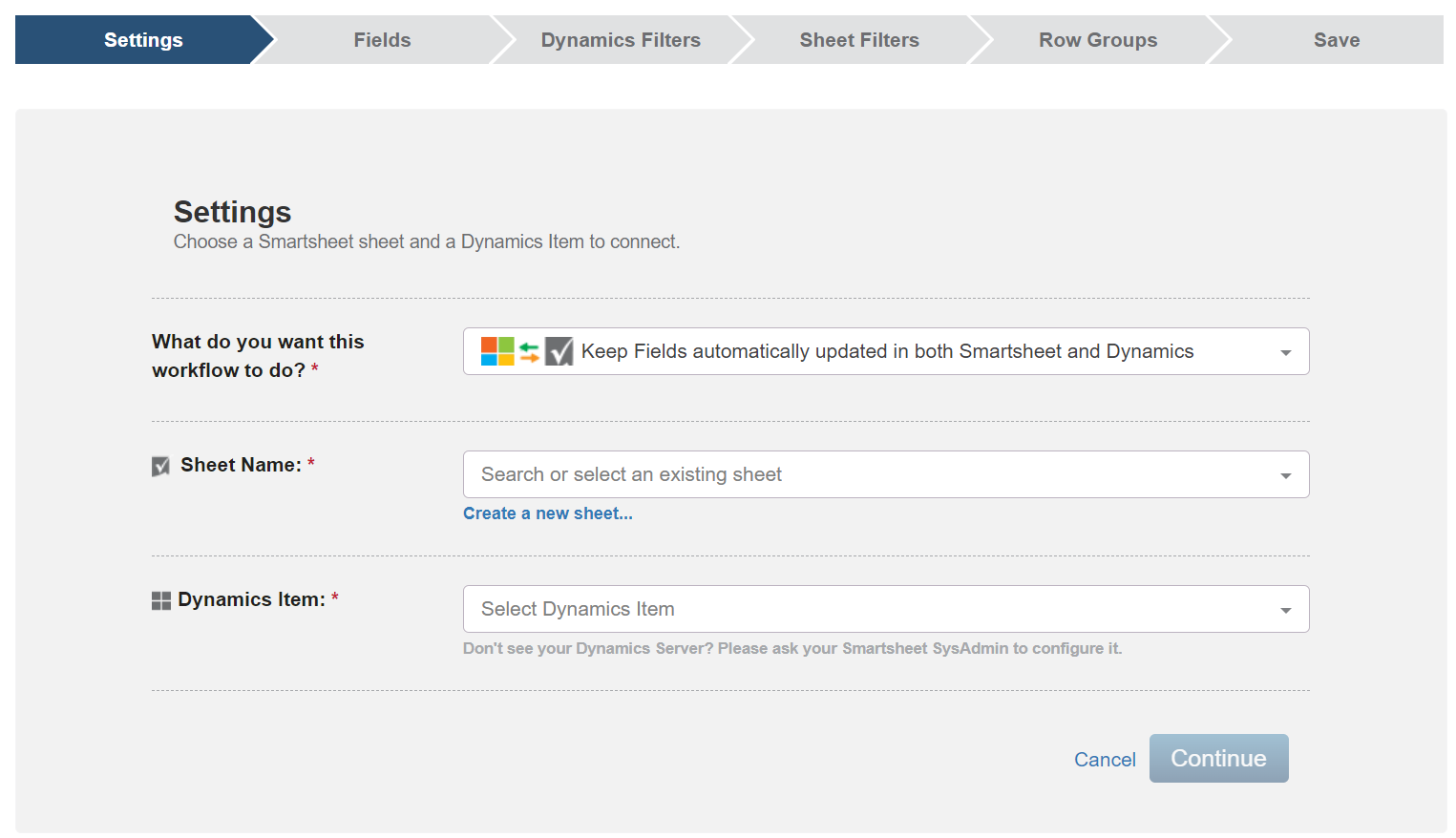Use the Microsoft Dynamics 365 Connector to automatically sync Leads, Opportunities, Accounts, Contacts, and other Dynamics 365 entities between Smartsheet and Dynamics 365.
Once you’ve purchased the Smartsheet for Dynamics 365 Connector, follow the Admin setup.
Create a workflow
After logging in, the workflow wizard can guide you through creating workflows for automatic sync.
- Select the menu in the upper-left corner of the page and select Dashboard.
- Select Add Workflow to start the workflow wizard.
Workflow wizard
Use the workflow wizard to select your sheet and Microsoft Dynamics entity, and map their respective columns and fields for synchronization.
On the Settings page, establish the basics for your workflow:
- What do you want this workflow to do?: Choose the sync direction of the workflow (to Dynamics 365, to Smartsheet, or bidirectionally between the two applications).
- Sheet Name: Select an existing sheet or Create a new sheet to create a new sheet in Smartsheet immediately.
- Dynamics Item: Select a Dynamics 365 entity from the dropdown.
Once you've saved the workflow, you can’t modify the sheet, Dynamics 365 entity, and sync directions; however, you can create a new workflow to select different settings.
- Select Continue to confirm your settings.
- Use the Fields section to map the fields between Dynamics 365 and Smartsheet.
You can select New column in the dropdown to insert a new column in the sheet. You can also select Add field to include more Dynamics 365 entity fields in the workflow. You can alter the sync direction using the flow dropdowns between entity fields and columns.
You may be unable to modify the sync directions of specific mappings based on your permissions in Dynamics 365 and Smartsheet, as well as the field’s use in the integration (such as the Dynamics ID).
- Select Continue to confirm your field mapping choices.
- On the Dynamics Filters and Sheet Filters pages, you can create filters to better control the type and amount of data shared between the two applications.
- On the Save page, name your workflow, save it, and review a summary of the updates to your Dynamics 365 entity and sheet.
If you want to make any modifications, you can step back into the workflow and add your changes. - Select Save Workflow to start the workflow sync.
Once you save the workflow, you can complete the wizard and go to the Dashboard. Your workflow automatically updates records in Dynamics 365 and rows in your Smartsheet sheet according to the workflow rules.
Use filters to fine-tune data synchronization
Dynamics filters
You can add filters to regulate the Dynamics 365 records that flow into the sheet. These filters help ensure you sync only fields pertaining to a specific project, client, or employee.
To create Dynamics filters:
- Select Add filter to populate the list of available entity fields.
Use the dropdown to select the filter's condition, such as equals, contains, or is blank.
A text field appears on the right if you need to enter additional filter criteria.
- Select Continue to confirm and apply the filters.
Sheet filters
You can add filters to control the rows that sync to objects in Dynamics 365. You can use these filters to regulate the records that sync back to your object. For example, use a filter to sync only specific rows with a Status Reason value of In Progress back to the Opportunity entity in Dynamics 365.
To create sheet filters:
- Select Add filter to populate the list of available sheet columns, and select a column to populate the filter.
Use the dropdown to select the filter's condition, such as equals, contains, or is blank.
A text field appears on the right if you need to enter additional filter criteria.
- Select Continue to confirm and apply the filters.
For both filters on the Save page of the wizard, next to Update Summary, you can see the number of fields to be updated in your Dynamics 365 entity. This helps measure the amount of data flowing into the entity from your sheet.
If the Update Summary count appears unexpectedly high or low, you can go back to add or remove filters as needed.
Keep related records together with Smartsheet hierarchy
Define row groups in your workflow to keep your Dynamics 365 records together as parent and child tasks in Smartsheet. Create row groups to have your workflow organize Dynamics 365 records by specific fields, like Opportunity Stages, without manually moving them around in your sheet after they sync.
Keep the following in mind when defining row groups:
- In Group by, you can select an existing Dynamics 365 field or type a new value to group records as they sync to your sheet. The Group by determines the Primary column value of the parent rows in your sheet. For example, when you Group by the Stage of an Opportunity, parent rows are created in your sheet for each stage (such as Proposal, Qualify, Contract).
- New parent rows appear at the bottom of your sheet unless your Group by completely matches an existing Primary column value in the sheet.
- You can define a sub-group for an additional layer of organization. For example, have records sync underneath an International parent row that is also a child to a Sales row in Smartsheet.
- The correct hyperlinks must be in the Primary ID column on your sheet for Dynamics 365 records. If a Primary ID column doesn’t exist, it is automatically added when the workflow runs for the first time.
Manually copying and pasting Dynamics IDs from Dynamics 365 into your sheet may cause the workflow not to sync as expected.
Manage workflows
You can manage workflows from the Dashboard. Select the three-line menu in the upper-left corner of the page and select Dashboard to see a list of the workflows you’ve created.
Settings
Select Settings to:
- Edit Workflow: Takes you back through the workflow wizard to make changes to the workflow.
- Rename Workflow: Change the title of the workflow.
- Deactivate/Enable Workflow: Stops or starts automation of the workflow.
- Delete Workflow: Removes the workflow from the Dashboard.
Deleting a workflow can't be undone, and deleted workflows can't be recovered.

